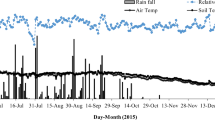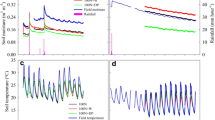Abstract
Losses of nitrogen were investigated after applications of ammonium bicarbonate and urea to flooded rice at transplanting. Ammonia (NH3) volatilization was determined by direct micrometeorological methods, and total loss of fertilizer nitrogen (N) was measured by15N balance. All the loss appeared to be in gaseous forms, since there was no evidence of leaching and runoff was prevented. The difference between N loss and NH3 loss was thus assumed to be denitrification loss.
Both NH3 volatilization and denitrification losses were large, being 39% and 33%, respectively, of the ammonium bicarbonate N, and 30% and 33%, respectively, of the urea N applied by farmers' methods.
Ammonia fluxes from the field fertilized with ammonium bicarbonate were very high for two days, and then declined rapidly as the NH3 source in the floodwater diminished. Moderate fluxes from the field fertilized with urea continued over 6 days, but calculations showed that NH3 transfer from floodwater to atmosphere was retarded during the middle period of the experiment, particularly on day 2 when a thick algal scum appeared on the water surface. The results indicate that this algal mass obstructed the transport of NH3 across the water-air interface until the scum was dispersed by wind action. Nevertheless, the prolonged NH3 losses on the urea treatment were due primarily to high floodwater pH values promoted by the strong algal growth during the daylight hours.
Nitrogen-15 balance studies showed that incorporation of fertilizer into drained soil substantially increased recoveries of fertilizer N in rice plants and soil compared with incorporation of fertilizer in the presence of standing floodwater. Ammonia loss measurements on these treatments when urea was applied suggested that the improvement in fertilizer N efficiency was due mainly to reductions in NH3 loss.
Similar content being viewed by others
References
Cai Gui-xin, Zhu Zhao-liang, Trevitt ACF, Freney JR and Simpson JR (1986) Nitrogen loss from ammonium bicarbonate and urea fertilizers applied to flooded rice. Fert Res 10: 203–215
De Datta SK, Obcemea WN, Chen RY, Calabio JC and Evangelista RC (1987) Effect of water depth on nitrogen use efficiency and nitrogen-15 balance in lowland rice. Agron J 79: 210–216
Denmead OT, Freney JR and Simpson JR (1982) Dynamics of ammonia volatilization during furrow irrigation of maize. Soil Sci Soc Am J 46: 149–155
Denmead OT, Simpson JR and Freney JR (1977) A direct field measurement of ammonia emission after injection of anhydrous ammonia. Soil Sci Soc Am J 41: 1001–1004
Fillery IRP, Simpson JR and De Datta SK (1984) Influence of field environment and fertilizer management on ammonia loss from flooded soil. Soil Sci Soc Am J 48: 914–920
Freney JR, Leuning R, Simpson JR, Denmead OT and Muirhead WA (1985) Estimating ammonia volatilization from flooded rice fields by simplified techniques. Soil Sci Soc Am J 49: 1049–1054
Leuning R, Denmead OT, Simpson JR and Freney JR (1984) Processes of ammonia loss from shallow floodwater. Atmos Environ 18: 1583–1592
Li CK and Chen RY (1980) Ammonium bicarbonate used as a nitrogen fertilizer in China. Fert Res 1: 125–136
Mikkelsen DS, De Datta SK and Obcemea WN (1978) Ammonia volatilization losses from flooded rice soils. Soil Sci Soc Am J 42: 725–730
Orion (1983) Instruction manual for ammonia electrode model 95-12. Cambridge, Mass: Orion Research Inc
Simpson JR and Freney JR (1988) Interacting processes in gaseous nitrogen loss from urea applied to flooded rice fields. In: Urea Technology and Utilization. Kuala Lumpur, Malaysia: Malaysian Society for Soil Science (in press)
Simpson JR, Freney JR, Wetselaar R, Muirhead WA, Leuning R and Denmead OT (1984) Transformations and losses of urea nitrogen after application to flooded rice. Aust J Agric Res 35: 189–200
Simpson JR, Freney JR, Muirhead WA and Leuning R (1985) Effects of phenylphosphorodiamidate and dicyandiamide on nitrogen loss from flooded rice. Soil Sci Soc Am J 49: 1426–1431
Simpson JR, Muirhead W, Bowmer KH, Cai GX and Freney JR (1988) Control of gaseous nitrogen losses from urea applied to flooded rice soils. Fert Res (in press)
Zhu ZL, Chen RY, Xu YF, Xu YH and Zhang SL (1979) The effect of forms and methods of placement of nitrogen fertilizer on the characteristics of the nitrogen supply in paddy soils. Acta Pedol Sin 19: 218–233
Zhu Zhao-liang (1987)15N balance studies of fertilizer nitrogen applied to flooded rice fields in China. In: Freney JR, Wetselaar R, Trevitt ACF and Simpson JR (eds) Efficiency of Nitrogen Fertilizers for Rice. pp. 163–167 Los Baños, Philippines: International Rice Research Institute
Author information
Authors and Affiliations
Rights and permissions
About this article
Cite this article
Zhu, Z.L., Cai, G.X., Simpson, J.R. et al. Processes of nitrogen loss from fertilizers applied to flooded rice fields on a calcareous soil in north-central China. Fertilizer Research 18, 101–115 (1988). https://doi.org/10.1007/BF01049507
Received:
Accepted:
Issue Date:
DOI: https://doi.org/10.1007/BF01049507




